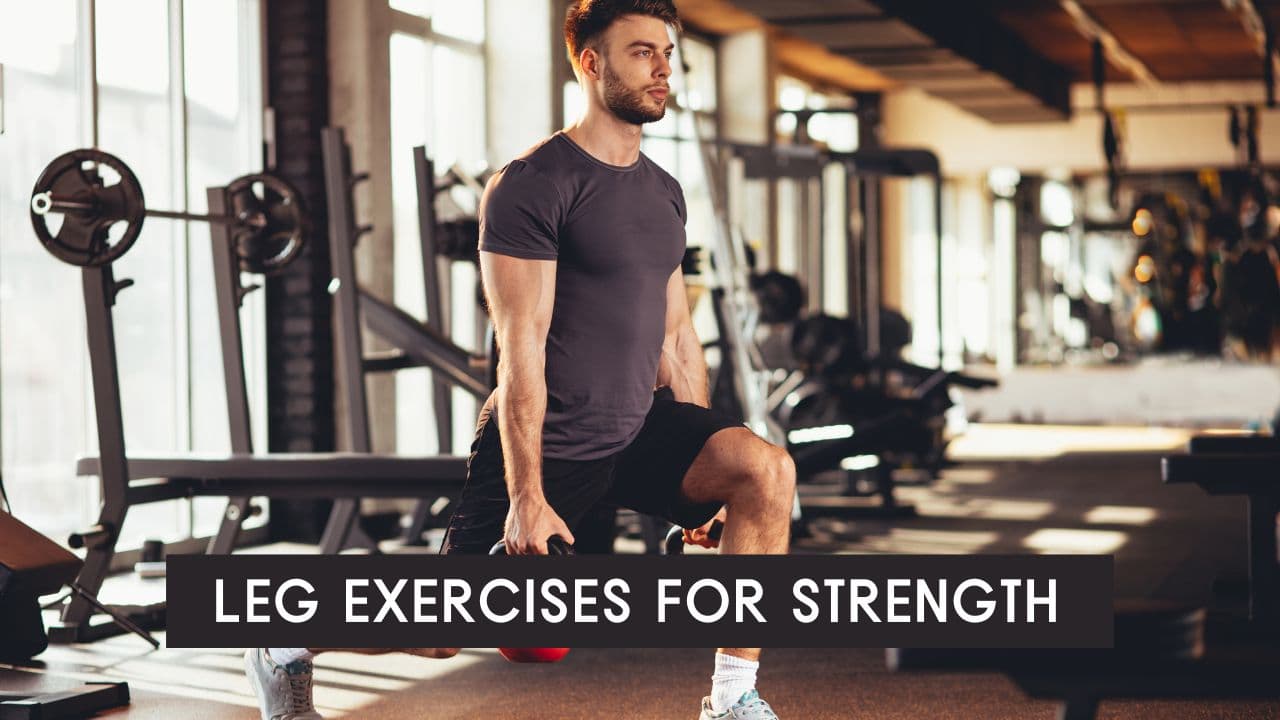Why Leg Day Still Rules
Somehow, leg day is still the one session people try to sneak away from, even though it quietly decides how strong, fast, and durable you feel in real life. Powerful legs drive everything from sprint speed to how easily you climb stairs with groceries in both hands, and they torch a shocking amount of calories while they are at it.
This guide pulls together 12 tried-and-tested movements from the LoadMuscle thighs exercises, giving you a toolkit to train quads, hamstrings, glutes, and adductors from multiple angles with whatever you actually have access to: barbells, dumbbells, machines, bands, even that beaten-up kettlebell in the corner.
How to Use This Guide
Instead of treating this like a strict program, think of it as a menu you can build from.
- Start every serious leg session with one heavy, bilateral squat or hinge as your main strength piece.
- Layer in unilateral work next to clean up side-to-side imbalances and light up your core more than you probably expect.
- Flip back and forth between quad-dominant and hamstring-dominant accessories so your knees, hips, and lower back stay happy long term.
- Wrap things up with machine or band isolation moves when you want to chase the burn, build detail, and get that “yep, I really trained” feeling.
- Change the tools you use (barbell vs machine vs sled vs bands) every 4–6 weeks so you can keep progressing loads without getting mentally fried.
Leg Exercise Snapshot
| # | Exercise | Equipment | Target | Intensity |
|---|---|---|---|---|
| 1 | Band Single Leg Split Squat | Band | Gluteus Maximus | Medium |
| 2 | Barbell High Bar Squat | Barbell | Quadriceps | High |
| 3 | Barbell Clean Deadlift | Barbell | Hamstrings | High |
| 4 | Dumbbell Romanian Deadlift | Dumbbell | Gluteus Maximus | Medium |
| 5 | Dumbbell Bulgarian Split Squat | Dumbbell | Gluteus Maximus | Medium |
| 6 | Kettlebell Goblet Squat | Kettlebell | Quadriceps | Medium |
| 7 | Lever Leg Extension | Machine | Quadriceps | Medium |
| 8 | Lever Lying Leg Curl | Machine | Hamstrings | Medium |
| 9 | Sled 45° Leg Press | Sled machine | Gluteus Maximus | High |
| 10 | Glute Ham Raise | Body weight | Hamstrings | Medium |
| 11 | Walking Lunge | Body weight | Quadriceps | Medium |
| 12 | Resistance Band Lunge | Band | Gluteus Maximus | Medium |
The 12 Best Leg Exercises for Strength & Hypertrophy
You will find each movement below with a thumbnail, a few coaching cues, and one simple way to progress it so you can plug it into your training without overthinking every little detail.
1. Band Single Leg Split Squat
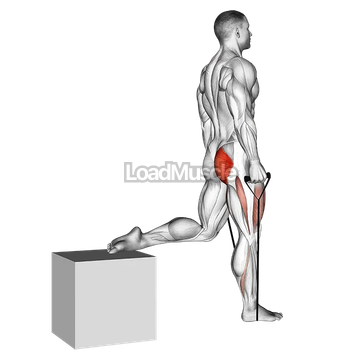
Primary focus: Gluteus Maximus & quads
Why it matters: This is your “no excuses” leg move. It fits in a suitcase, attacks imbalances side-to-side, and loads the rear chain through a long, very leg-day-ish range of motion.
Coaching cues
- Fix the band low to a sturdy anchor and step into a split stance so the front knee stacks right above the ankle.
- Drop the back knee toward the floor until it hovers just above the ground, keeping your torso slightly inclined forward.
- Drive up through the front mid-foot while staying strong against the pull of the band so the knee does not cave in.
Progression idea: Bump up the challenge by adding a 2-second pause at the bottom of each rep or switching to a thicker band and working up to 3×12 reps per leg.
2. Barbell High Bar Squat
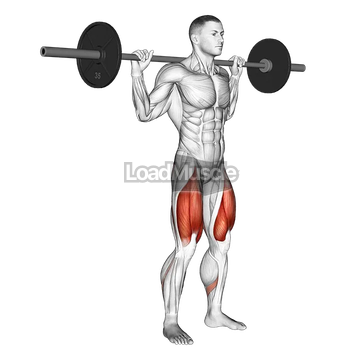
Primary focus: Quadriceps & glutes
Why it matters: This is the classic squat that most people picture instantly. It builds huge quad mass, strong glutes, and an upright, athletic posture that carries over to sports, running, and everyday lifting.
Coaching cues
- Take a grip just outside shoulder width and position the bar high across your traps, not drifting down to mid-back.
- Sit your hips straight down between your heels, letting the knees travel in line with your toes instead of forcing them to stay perfectly vertical.
- Push the floor away explosively while keeping your core tight so your chest does not collapse.
Progression idea: Cycle your training by running a heavy week of low-rep triples, followed by a week of classic 5×5 volume to drive both strength and size.
3. Barbell Clean Deadlift
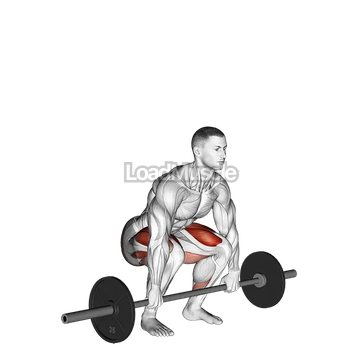
Primary focus: Hamstrings, glutes, spinal erectors
Why it matters: Think of this as the deadlift’s athletic cousin. It builds serious posterior-chain strength, boosts your ability to finish squats, and sets up better power for Olympic lifts and jumps.
Coaching cues
- Set your hips just slightly above knee height, keep your shins close to vertical, and pull your lats tight like you are trying to bend the bar into you.
- Push the floor away rather than “yanking” the bar up, letting it stay almost glued to your legs on the way up.
- Finish tall with glutes squeezed and ribs stacked down, not leaning back awkwardly at the top.
Progression idea: Try a simple 4-week wave: run sets of 5, then 3, then 2 reps each week while adding chains or bands if you have them to build power through the entire pull.
4. Dumbbell Romanian Deadlift

Primary focus: Gluteus Maximus & hamstrings
Why it matters: This is a pure hip hinge that keeps tension on the hamstrings and glutes the whole time. It is perfect as an accessory on heavy days or as the main lift when you are chasing hypertrophy instead of max numbers.
Coaching cues
- Hold the dumbbells in front of your thighs with a slight bend in your knees, not locked out.
- Push your hips back and hinge until you feel a solid stretch through the hamstrings while keeping your spine long and neutral.
- Drive your hips forward to stand tall, squeezing your glutes at the top without slamming your lower back.
Progression idea: Slow the descent to about 3 seconds for each rep or stand on small blocks for a deficit version to slightly increase your range of motion and muscle recruitment.
5. Dumbbell Bulgarian Split Squat
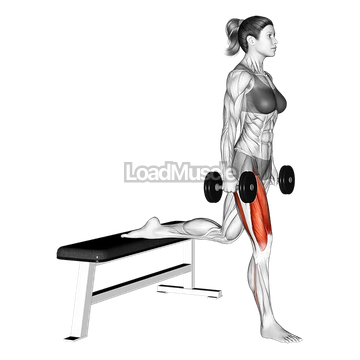
Primary focus: Gluteus Maximus & quads
Why it matters: This one has a reputation. It delivers brutal unilateral volume, trains balance and hip stability, and mimics the mechanics of sprinting more than you might expect from something done in place.
Coaching cues
- Place your back foot on a bench or box, lean your torso slightly forward, and let your arms hang naturally with the dumbbells.
- Drop your hips straight down rather than lunging forward, keeping the front shin fairly vertical.
- Drive up through the front foot and finish each rep with a controlled squeeze of the glute, not a bounce.
Progression idea: Load only one side (dumbbell in the hand opposite the working leg) to challenge core stability or add a couple of small pulses at the bottom of each rep.
6. Kettlebell Goblet Squat
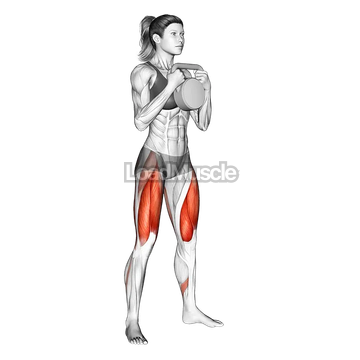
Primary focus: Quadriceps & core
Why it matters: This is the “teaching squat.” It helps you find depth, stay upright, and actually feel what a solid brace through your midsection is supposed to feel like. Great for beginners, warm-ups, or high-rep finishers.
Coaching cues
- Hold the kettlebell close to your chest like a heavy book, with elbows tucked toward your ribs.
- Sit down between your heels, letting the kettlebell act as a counterweight so you can reach depth without falling backward.
- As you pass the sticking point on the way up, let a small controlled breath out to keep your core engaged.
Progression idea: Try 1½-rep sets: go all the way down, come halfway up, drop back down, then stand tall. Start with 3×10 and see how quickly your quads notice.
7. Lever Leg Extension
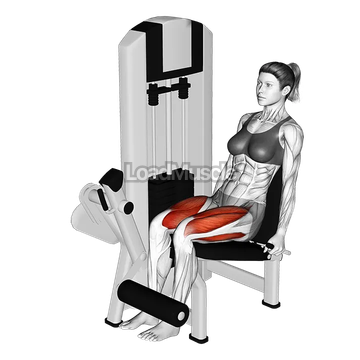
Primary focus: Quadriceps isolation
Why it matters: When you want your quads to carry the whole load, this is the move. It builds knee-extension strength, adds that front-of-thigh “teardrop” look, and, when balanced with heavy compounds, helps keep your knees resilient.
Coaching cues
- Adjust the pad so your knees line up with the machine’s pivot point, not in front of it or behind it.
- Control the lowering phase for 2–3 seconds, then extend forcefully without losing tension.
- Squeeze at the top of each rep without snapping your knees into hard lockout.
Progression idea: Finish your session with a nasty drop set or a few very slow negative reps to drive high levels of metabolic stress into the quads.
8. Lever Lying Leg Curl
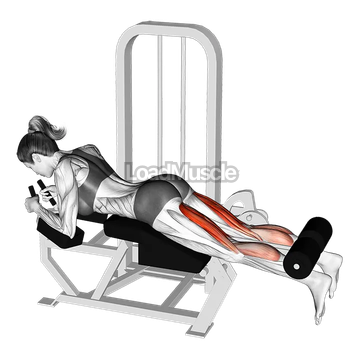
Primary focus: Hamstrings
Why it matters: Direct hamstring work keeps your quad volume in check, supports knee health, and pays off in faster acceleration when you sprint, change direction, or just chase the bus a bit too late.
Coaching cues
- Press your hips firmly into the pad to stop your lower back from arching and stealing tension.
- Curl your heels toward your glutes without letting your knees lift off the pad in the process.
- Lower the weight under control so the hamstrings stay loaded instead of just dropping the stack.
Progression idea: Use a rest-pause cluster: hit 10 challenging reps, rest briefly, then do 5 more, rest again, then squeeze out another 5 at the same weight.
9. Sled 45° Leg Press
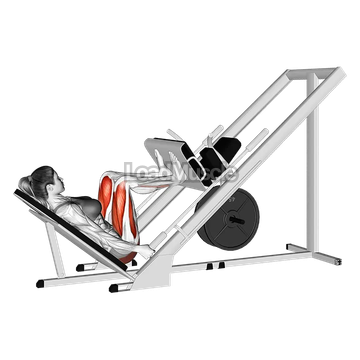
Primary focus: Gluteus Maximus & quads
Why it matters: The leg press lets you load the lower body heavily without beating up your torso or demanding perfect barbell technique. It is ideal for higher-volume hypertrophy blocks and for those legendary drop sets people talk about a bit too proudly.
Coaching cues
- Keep your hips pinned to the seat and lower the sled until your thighs are right up against your torso, as long as your form stays solid.
- Push through your mid-foot, avoiding sharp lockout at the knees at the top.
- Play with stance: go narrower to emphasize quads or a bit wider to invite more glute involvement.
Progression idea: Add short bouts of blood-flow-restriction (BFR) work if you know how to do it safely or finish with 20–30 rep burnouts after your heavier sets.
10. Glute Ham Raise

Primary focus: Hamstrings & glutes
Why it matters: This is one of the most brutally effective bodyweight posterior-chain exercises available in a well-equipped gym. It teaches your hamstrings to handle both knee flexion and hip extension at the same time, which is exactly what they do when you sprint or jump.
Coaching cues
- Set the pads so your knees rest just in front of the pivot point, not way behind it.
- Lower yourself under control until your torso is close to parallel with the floor, then drive your toes into the plate to pull yourself back up.
- Keep your glutes lightly squeezed so your lower back does not sway into hyperextension.
Progression idea: Once bodyweight reps are strong, hug a small weight plate to your chest for added load or use a band to assist if you want higher volume while you are still learning the pattern.
11. Walking Lunge

Primary focus: Quadriceps & glutes
Why it matters: Walking lunges blend strength, balance, and conditioning into one move. They feel a bit like life: one step at a time, sometimes wobbly, but they build coordination and toughness that shows up outside the gym too.
Coaching cues
- Take medium-length steps, not tiny shuffles or massive lunges, keeping ribs stacked right over your hips.
- Drop the back knee straight down to the floor while the front shin stays mostly vertical.
- Push through the heel of the front foot and drive yourself forward without letting your torso twist all over the place.
Progression idea: Add a 2-second descent on each rep or start carrying dumbbells or kettlebells once unweighted sets of 20+ strides feel too easy.
12. Resistance Band Lunge

Primary focus: Gluteus Maximus & quads
Why it matters: No rack, no problem. This variation lets you turn a tiny space into a working leg-day setup and is ideal for travel, home workouts, or high-rep finishers where you just want to feel the muscles working hard.
Coaching cues
- Trap the band securely under your front foot and bring the handles or ends up around shoulder height.
- Step back into a lunge, keeping your torso tall with your core lightly braced, not overarched.
- Drive up through the front foot while managing the band’s upward pull so you do not get yanked off balance.
Progression idea: Pair these with walking lunges in a superset or add a quick knee drive at the top for a more explosive, athletic feel.
Weekly Leg Programming Templates
If you like a bit more structure (a lot of us do), here are simple weekly templates you can tweak based on your experience and recovery.
| Level | Frequency | Structure | Volume Focus | Notes |
|---|---|---|---|---|
| Beginner | 2× / week | 1 squat + 1 hinge + lunges | 2–3 sets of 10–12 | Focus on clean technique, steady tempo, and getting comfortable with bodyweight and light loads first. |
| Intermediate | 2–3× / week | Heavy squat day + posterior-chain day + unilateral finisher | 3–4 sets of 6–12 | Rotate between bilateral and unilateral emphasis, mix rep ranges, and track how your joints feel from week to week. |
| Advanced | 3× / week | Strength, volume, and pump sessions | 4–5 sets of 5–15 | Layer in intensity techniques (drop sets, pauses, BFR) while monitoring total weekly hard sets (around 12–18 for most people). |
Sample Splits
These are not strict rules, more like starting points you can adjust the way you adjust your Spotify playlist when a song just is not it today.
- Push/Pull/Legs: Leg day = Barbell High Bar Squat → Dumbbell Romanian Deadlift → Lever Leg Extension → Walking Lunge finisher.
- Upper/Lower: Lower A = Clean Deadlift–focused day; Lower B = Bulgarian Split Squat plus Leg Curls as main accessories.
- At-Home: Band Split Squat → Resistance Band Lunges → Goblet Squat (using a backpack if needed) → Walking Lunge carries in your hallway or backyard.
Build Your Personalized Leg Plan
If you prefer having the thinking handled for you, LoadMuscle’s AI Workout Planner can assemble a lower-body plan around your real life instead of an idealized version of it. It pulls from the same thighs database you see here, then balances equipment access, training age, and how much recovery time you realistically have.
✔ Auto-structured set & rep schemes
✔ Smart rotation of exercises so you do not get stuck doing the same thing for months
✔ Built-in mobility and isolation work so the “small stuff” does not get forgotten
👉 Build your custom split here: Online Fitness Planner
Conclusion
Serious leg development is not just heavy squats or just lunges or just machines. It is the mix: big bilateral lifts, precise unilateral work, and thoughtful isolation finishers that keep your joints feeling okay while your numbers and your muscle size climb.
Cycle through these 12 essentials, write down your loads, notice how your legs feel over a few weeks, and lean on the workout planner anytime you want a fresh structure without starting from scratch again and again.
